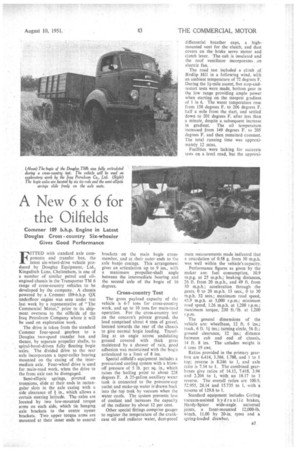A New 6 x for the Oilfields
Page 41

If you've noticed an error in this article please click here to report it so we can fix it.
Commer 109 b.h.p. Engine in Latest Douglas Cross -country Six-wheeler Gives Good Performance
F. ITTED with standard axle components and transfer box, the latest six-wheel-drive vehicle produced by Douglas Equipment,. Ltd„ Kingsditch Lane, Cheltenham, is one of a number of similar petrol and oilenginerl chassis in the Transporter TM 6 range of cross-country vehicles to be developed by the company. A chassis powered by a Commer 109-b.h.p. QX underfloor engine was seen under test last week by a representative of "The Commercial Motor," prior to its shipment overseas to the oilfields of the Iraq Petroleum Company where it will be used on exploration work.
The drive is taken from the standard Commer four-speed gearbox to a Douglas .two-speed transfer box and thence, by separate-propelkr shafts, to. spiral-bevel-driven fully floating bogie axles. The divided drive to the rear axle incorporates a taper-roller bearing mounted on the easing of the intermediate axle. Four-wheel drive is used for main-road work, when the drive to the front axle can be disengaged.
Semi-elliptic springs, pivoted on trunnions, slide at their ends in rectangular slots in the axle casing with a side clearance. of 4 in., which allows a certain steering latitude. The axles are located by two 'WI-AT-mounted torque arms on each side, which fie, hanging axle brackets to the centre oyster brackets. Two upper torque arms are mounted at their inner ends to central brackets on the main bogie crossmember, and at their outer ends to the axle banjo casings. This arrangement gives an articulation up to 9 ins., with a maximum propeller-shaft angle between the intermediate bearing and the second axle of the bogie of 16 degrees.
Cross-country Test The gross payload capacity of the vehicle is 6-7 tons for cross-country work, and up to 10 tons for main-road operation. For the cross-country test on the concern's private ground, the load comprised about 4 tons of gravel, located towards the rear of the chassis to give normal bogie loading. Travelling at an angle across undulating ground covered with thick grass moistened by a shower of rain, good adhesion was maintained with the bogie articulated to a limit of 8 ins.
Special oilfield's equipment includes a pressurized cooling system with a blowoff pressure of 5 lb. per. sq. in., which raises the boiling point to about 228 degrees F. A 25-gallon auxiliary water tank is connected to the pressure-cap outlet and make-up wafer is`drawn hack into the top tank by vacuum when the water cools. The system prevents loss of coolant and increases the capacity of the radiator by about 12 per cent.
Other special fittings comprise gauges to register the temperature of the crankcase oil and radiator water, dust-proof differential breather caps, a highmounted vent for the clutch, and dust covers on the brake servo motor and clutch lever. The cab is insulated and the roof ventilator incorporates an electric fan.
The road test included a climb. Birdlip Hill in a following wind, with an ambient temperature of 72 degrees F. During the 14-mile ascent, five stop-andrestart tests were made, bottom gear in the low range providing ample power when starting on the steepest gradient of 1 in 6. The water temperature rose from 158 degrees F, to 206 degrees F. half a mile from the start, and settled down to 201 degrees F, after less than a minute, despite a subsequent increase in gradient. The oil temperature increased from 149 degrees F. to 205 degrees F. and then, remained constant. The total running time was approximately 12 mins.
Facilities were lacking for accurate tests on a level road, but the approxi mate measurements made indicated that a retardation of 0.58 g. from 30 m.p.h. was well within the vehicle's capacity.
Performance figures as given by the maker are: fuel consumption, 10.9 m.p.g. at 25 m.p.h.; braking distances, 26 ft. from 20 m.p.h., and 49 ft. from 30 m.p.h.; acceleration through the gears, 0 to 20 m.p.h. 13 secs., 0 to 30 m.p.h. 32 secs.; maximum road speed, 45.9 m.p.h. at 3,000 r.p.m.; minimum road speed, 1.26 m.p.h. at 1,200 r.p.m.. maximum torque, 230 ft./lb. at 1,206 r The general dimensions of the vehicle are: wheelbase, 12 ft. 6 ins.; track, 6 ft. 14 ins.; turning circle, 56 ft.; ground clearance, 12 ins.; distance between cab and end of chassis, 14 ft. 8 ins. The unladen weight is 4 tons 19 cwt Ratios provided in the primary gearbox are 6.414, 3.366, 1.788, and 1 to 1 top; reverse is 8.246 to 1, and axle ratio is 7.14 to 1. The combined gearboxes give ratios of 14.13, 7.418, 3.94 and 2,204 to 1, with an 18.17 to reverse. The overall ratios are 100.9, 52.955, 28.14 and 15.735 to 1, with a reverse of 129.8 to I.
Standard equipment includes Girling vacuum-assisted hydra ulie brakes, Hardy-Spicer wide-angle universal joints, a front-mounted 12,000-lb. winch, 11.00 by 20-in. tyres and a spring-loaded drawbar.




















































































